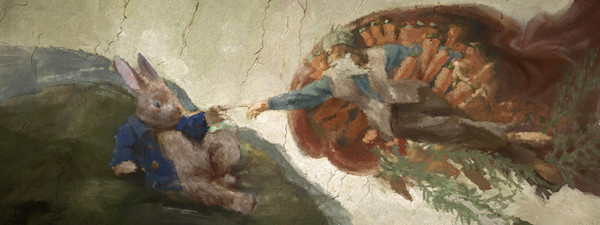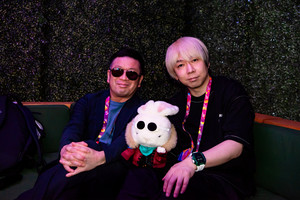An In-Depth Preview of Rusty Rabbit Game with Writer Gen Urobuchi and Producer Yuichiro Saito
by Kalai Chik,Gen Urobuchi's latest game caught the attention of gamers and anime fans alike with its recent story and character trailer. NetEase first teased Rusty Rabbit with a concept trailer at Tokyo Game Show 2023, and now both Urobuchi and producer Yūichirō Saitō (Chime Co., Ltd.) are excited to tell the world more about this unique title ahead of its September 24, 2024 launch date. In addition to Urobuchi and Saito, the development team brings together other hit makers in Japan, such as Kanaban Graphics (creator of Usavich) and Busted Rose's Gin (music composer for Pop Team Epic).

The side-scrolling Metroidvania game follows Stamp, a middle-aged rabbit voiced by Takaya Kuroda, as he explores ruins in search of his daughter. With a long list of well-known Japanese voice actors such as Tomokazu Sugita, Ai Fairouz, Shō Hayami, and many more, anime fans are in for a treat as they meet the team of unique rust diggers known as the Black-Berries (shortened as BB).
Although known for his darker stories, such as Saya no Uta, Puella Magi Madoka Magica, and Psycho-Pass, Urobuchi decided to do something different. "I wanted to actually focus more on what happens to a washed-up, middle-aged man," he said bluntly. "But that, in and of itself, would have been way too heavy. We offset it with these adorable rabbit-like characters."
As I sat down to talk with Urobuchi and Producer Saito, they introduced me to the hysterical premise of Rusty Rabbit's world with Mikey McNamara translating their tale. We start with Stamp, who got into a fight with his family and now lives alone. The setting takes place in a world left in ruin by Giants (humans) and the elevator they built to send resources into outer space. Rabbits have inherited the planet but hilariously misinterpreted Beatrix Potter's Peter Rabbit and took it as their Bible.

"The rabbits misunderstood human civilization, so they thought they were the chosen ones by God. In this religion, Peter fended off McGregor, the evil representative of the humans, and created this paradise utopia for the rabbits," said Urobuchi. "These ruins, or anything humans left behind, are deemed evil because they're all part of the people who tried to turn rabbits into a pie. That's why outlaws are the ones who have to scavenge and scrap all the junk."
The story itself is straightforward as the player goes between the village and the ruins near Smokestack Mountain, collecting scrap metal to upgrade weapons. There's a heavy RPG component, which Producer Saito demonstrated during the interactions between Stamp and the other rabbits in the game. Once we entered the battle system, parts of the menu and UI reminded me of Zero Escape: The Nonary Games. Weapons have different functions, as well as strengths and weaknesses, based on their purpose: from drilling down walls to combatting enemies. The impressive action sequence during the battle against a heavily armed machine showed a variety of game mechanics I didn't expect in a side-scroller.

Needless to say, Urobuchi's strength in dialogue and script writing shines through as characters banter with each other over what their name, "BB," even stands for during a life-or-death situation. Another scene that includes Urobuchi's trademark knack for storytelling is the commentary on how organized religion gatekeeps knowledge. At the church, the player must pay in carrot offerings to learn more about the mythology of the rabbit's religion. "He's a priest, but he's got a little bit of greed," laughed Saito.

Why is Rusty Rabbit's game rating at age 7+? I think it's a little difficult for kids.
Gen Urobuchi: I think kids are better at games than we think.
Yūichirō Saitō: Especially ones like Fortnite. But to get to what you just saw right now, I think it will take a lot of time and hundreds of hours.
How long has this game been in development?
SAITO: The concept of the entire project started about five years ago, but we didn't start heavy development until about two years ago.
UROBUCHI: I was just developing on my own a long time ago as a hobby, but when I showed it to NetEase, they said "Hey, we can actually make a proper game out of this."
SAITO: Needless to say, the story, the characters, and the world setting, we have the master with Urobuchi. We came in to support the project with the character design, artwork, and game development.
UROBUCHI: I made the original game as a hobby during the COVID lockdowns.

You've both worked on games with dark storylines. Urobuchi has worked on series like Saya no Uta and Psycho-Pass, while Saito has worked on Danganronpa. How did you work to land on the concept of Rusty Rabbit's cute nature?
SAITO: I think Urobuchi is known for very shocking or stimulating story twists, which he's done in anime but also within this game and its characters. But offsetting that with these cute character designs, I think it comes across as more lighthearted whether we're doing something serious or fun. We wanted to keep that kind of shocking nature of his storytelling but not feel like it overpowers the other aspects.
How big is the development team since this is a collaboration between Nitroplus, NetEase, and Chime?
SAITO: I would say about 50 to 60 people. There's an ongoing core team. Chime has been excellent about working with us, Nitroplus, and NetEase to execute all the different ideas we want to implement into the game.
Most of what you showed today is already in English. How closely have you been working with the translation team?
SAITO: Urobuchi wrote the scenario in Japanese, then it was translated into English. It is now being translated to French, German, Spanish, and Chinese.
discuss this in the forum (1 post) |